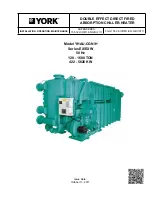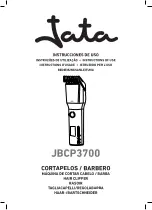
2
4.5 INCH HYDRAULIC CHIPPER
SAFETY
1.3 OPERATION SAFETY
1.4 MAINTENANCE & STORAGE SAFETY
1. Always stand clear of discharge area when operating
this machine. Keep face and body away from feed
and discharge openings.
2. Keep hands and feet out of feed
and discharge openings while
machine is operating to avoid
serious personal injury. Stop
and allow machine to come to
a complete stop before clearing
obstructions.
3. Set up your work site so you are not endangering
traffic and the public. Take great care to provide
adequate warnings.
4. Do not climb on machine when operating. Keep proper
balance and footing at all times.
5. Check cutting chamber to verify it is empty before
starting the machine.
6. The rotor will continue to rotate after being disengaged.
Shut off the machine and make sure all moving parts
have come to a complete stop before inspecting or
servicing any part of the machine. Disconnect the
battery and remove the ignition key if applicable.
1. Before inspecting, servicing, storing, or changing
an accessory, shut off the machine and make sure
all moving parts have come to a complete stop.
Disconnect the battery and remove the ignition key
where applicable.
2. Replace any missing or unreadable safety decals.
Refer to the safety decal section for part numbers.
3. Allow machine to cool before storing in an enclosure.
1.5 SAFETY DECAL LOCATIONS
The numbers below correspond to the decals in Section
1.6. Familiarize yourself with all of the safety and
operational decals on the machine and the associated
hazards. See the engine owner's manual or contact the
engine manufacturer for engine safety instructions and
decals. Make certain that all safety and operating decals
on this machine are kept clean and in good cond
4
ition.
Decals that need replacement must be applied to their
original locations.
7. Do not insert branches with a diameter larger than
5
4
the max chipper capacity into machine or machine
damage may occur.
8. When feeding material into machine, do not allow
7
metal, rocks, bottles, cans or any other foreign material
to be fed into the machine.
9. Ensure debris does not blow into traffic, parked cars,
or pedestrians.
6
10. Keep the machine clear of debris and other
accumulations.
11. Do not allow processed material to build up in the
discharge area. This may prevent proper discharge
and can result in kickback of material through the feed
opening.
12. If the machine becomes clogged, the cutting
2
mechanism strikes any foreign object, or the machine
starts vibrating or making an unusual noise, shut off
machine immediately and make sure all moving parts
have come to a complete stop. Disconnect the battery
and remove the ignition key if applicable. After the
machine stops: A) Inspect for damage, B) Replace
or repair any damaged parts, and C) Check for and
tighten any loose parts.
1
13. On electric start models, disconnect cables from battery
before doing any inspection or service. Remove key.
14. Check blade bolts for proper torque after every 8 hours
4
of operation. Check blades and rotate or resharpen
3
daily or as required to keep blades sharp. Failure to do
so may cause poor performance, damage or personal
injury and will void the machine warranty.










































